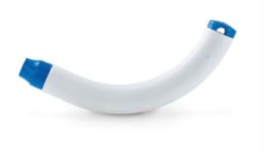Cornet
Original Editor - User Name
Top Contributors - Erika Rodrigues
Background[edit | edit source]
Positive pressure therapy (PEP) is used to enhance mucus clearance by either preventing the airways from collapsing by stenting them or through collateral ventilation that helps in increasing the intrathoracic pressure distal to the retained secretions or by increasing the functional residual capacity. Oscillatory positive expiratory pressure (OPEP) therapy was first developed in Switzerland. OPEP therapy combines the positive effects of PEP therapy with vibrations or oscillations and therefore has a two fold effect in airway clearance.[1]
Introduction[edit | edit source]
The cornet is a OPEP device. It consists of a semi-circular plastic tube. The exhaled air passes through the curved plastic tube which contains a flexible, latex free hose. During exhalation, the latex free hose strikes the top and bottom of the plastic tube irregularly which intermittently occludes flow and causes oscillations and positive expiratory pressure in the patients airways. The mouthpiece has settings that can be adjusted to twist the tube and increase the size of the expiratory resistor. This can adjust the frequency, amplitude and mean pressure. The cornet is gravity independent and can be used in any position.[2][3]
Types of Cornet[edit | edit source]
- RC-Cornet®
- RC-Cornet® PLUS - Further development of the RC-Cornet®
3. RC-Cornet® PLUS NASAL - Helps with mobilizing and removing secretions in the nasopharyngeal space. Positive pressure and vibrations are produced when the patient exhales through the nose that are then transmitted to the entire nasopharyngeal space.
4..RC-Cornet® PLUS Tracheo - Useful for patients who are tracheostomized. Helps to cough up thick secretions.
How to use[edit | edit source]
- Any preferable starting position can b chosen as the cornet is independent of gravitational forces.
- The lips should firmly hold onto the mouthpiece.
- Take a deep breath with your nose and with a forceful exhalation blow out into the device.
- Ideally, the exhalation should be twice as fast as normal. A low pitched harsh sound and vibration would be felt in the chest.
- This should be performed about 10-15 times followed by huff and cough to mobilize the secretion.
- This cycle can be repeated for 10 to 15 minutes or 3 sets of 10-15 repetitions.
- The mouthpiece can be twisted to increase the positive airway pressure and the vibration in the airways.[10][11]
Indications[edit | edit source]
- Emphysema
- Chronic Obstructive Pulmonary Disease (COPD)
- Cystic Fibrosis
- Bronchiectasis
- Chronic bronchitis
- Pneumonia
- Asthma
Contraindications[edit | edit source]
No absolute contraindications to the use of PEP therapy have been reported
Relative Contraindications :
- Intracranial pressure (ICP) > 20 mm Hg.
- Hemodynamic instability
- Recent facial, oral, or skull surgery or trauma
- Acute sinusitis
- Epistaxis
- Active hemoptysis
- Untreated pneumothorax
References[edit | edit source]
- ↑ Ni Y, Ding L, Yu Y, Dai R, Chen H, Shi G. Oscillatory positive expiratory pressure treatment in lower respiratory tract infection. Experimental and therapeutic medicine. 2018;16(4):3241–3248.
- ↑ Muthukumar TS, Thekkinkattil MK. Effect of cornet device to clear the excess trachea bronchial secretions in a 45 year old right middle and lower lobe pneumonia patient- a case report. MOJ Yoga Physical Ther. 2016;1(1):1-3.
- ↑ Fleet H V, Dunn D K, McNinch N L, Volsko T A. Evaluation of Functional Characteristics of 4 Oscillatory Positive Pressure Devices in a Simulated Cystic Fibrosis Model. Respiratory Care.2017;62 (4):451-458.
- ↑ CEGLA Medizintechnik. PEP-Device RC-Cornet® PLUS. Available from:https://www.youtube.com/watch?v=jAxIcK0vNuY&t=148s
- ↑ CEGLA Medizintechnik.RC-Cornet® PLUS - Application. Available from:https://www.youtube.com/watch?v=ATsPjgxUvl4&t=188s
- ↑ CEGLA Medizintechnik. RC-Cornet® PLUS NASAL - Active principle. Available from: https://www.youtube.com/watch?v=jUAxs7gLr4M
- ↑ CEGLA Medizintechnik. Application respiratory therapy device RC-Cornet® PLUS NASAL. Available from: https://www.youtube.com/watch?v=kOc9RFpXKLk
- ↑ CEGLA Medizintechnik. RC-Cornet® PLUS TRACHEO - Respiratory therapy. https://www.youtube.com/watch?v=2TL9Wj0yyVE
- ↑ CEGLA Medizintechnik. RC Cornet® (Basic Cornet) for mucous clearance and airway stabilization [HD]. Available from: https://www.youtube.com/watch?v=xc3EVm1Jf_Q
- ↑ S, Prem V ,Alaparthi G K , V, Acharya V. Comparison of acapella and RC-Cornet for airway clearance in bronchiectasis- A pilot study. International Journal of Current Research and Review. 2011;3(11):138-148
- ↑ A A V, K V, Alaparthi G K, Krishnan S, Z,Acharya V. Comparison of Quake and RC-Cornet for Airway Clearance in Bronchiectasis: A Randomized Crossover Trial. International Journal of Health Sciences and Research. 2012;2(6):20-27







